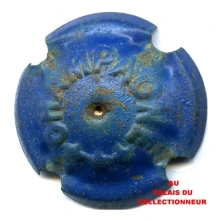champagne caps- A collection
Did you know that the name of the hobby where you collect Champagne caps is called Placomusophilia? Show of hands of people who think this hobby could use a new name?
Placomusophilia sounds like something that requires a course of antibiotics to clear up. It’s actually a hobby — collecting the colorful, unique metal caps found on the tops of Champagne and other sparkling wine corks.
But the word, placomusophilia, makes me cringe. And calling myself a placomusophile just sounds, well, sketchy.

The History Of The Name Placomusophilia
Placomusophilia comes from the French words plaque, for plate, and muselet, which is the wire basket that holds a sparkling wine cork in place.
Invented by Adolphe Jacquesson (of Jacquesson & Fils) in 1844, the the muselet is a very important piece of wine gear.
Prior to the muselet, corks were held in place with hemp twine and wax, which turned out to be rather unstable. Without the Champagne caps, corks had a habit of flying out of bottles willy-nilly. This was somewhat problematic, because when a cork flies out of a Champagne bottle, it can reach speeds of up to 50 miles per hour.
If you get hit in the face with one, it’s gonna leave a mark.
Jacquesson’s idea involved inserting a piece of metal between the top of the cork and its ties. This metal piece has four notches in it, which balance the forces acting on the cork, and allow the wires to be tightened more securely. Fewer flying corks.
The Value Of A Champagne Cap Collection
The earliest Champagne caps were nothing special to look at, but today, they can fetch some pretty steep prices. The blue cap shown above was recently for sale at €120.
No one plans to start a Champagne cap collection. (Similarly, no one plans to start a wine label collection but here we are)
It’s not like you wake up one day and say, “You know what? I don’t have enough going on in my life. I need to take up collecting champagne bottle caps…”
Or maybe you are a planner, who knows?
Most collectors have been collecting for years and years and have made it an art. It generally starts when the idea pops into your head that they’re just too pretty to throw away (and then poof! you turn into your grandmother).
Champagne caps are both fascinating and beautiful, perhaps even more so than wine labels. Some are quite striking and unique . . . and some are downright uninspired.
How To Display Your Champagne Cap Collection
So, what to do with the beauties? Show them off! My favorite ways are either in a piece of wall art or in a stunning statement piece of jewelry.
The wall art is just a fancy cork board I picked up at Home Goods decorated with giant Champagne cap thumb-tacks. All you have to do is make the thumb-tacks. If I can do it, you can do it. Easy-peasy.
I’ve seen shadow box Champagne cap displays that are under glass, but that’s too much of a commitment for me. The beauty with this board is that you can swap out caps if you get a more unusual one. I’ve also seen albums for Champagne caps, but why hide them in a book? What’s the point of a collection if you can’t see it?
You can buy these on Etsy.


DIY Champagne Cap Collection Display
You could also get a really cool vintage frame for this project, but then you’d have to measure, cut, and fit your own cork roll, and I don’t have the patience for that level of crafting.
To make the Champagne cap tacks, buy a package of plastic push pins and super-glue them to your caps.
Tip: I tried the flat-head metal tacks — they don’t work. Because Champagne caps are concave, the “pin” isn’t long enough once they are glued on to stick into the board.
The most frustrating thing about this project is that you don’t just open every bottle of bubbles and discover a beautiful, unique cap. There are duplicates, boring caps, and the inexplicably beige:
But once you’ve collected all your Champagne caps and turned them into giant thumb tacks, Et Voilà!
It’s okay to have duplicates I think. You can replace them as you get new caps.
A word of caution: You’ll want to be a little bit careful about the size of the cork board you select. Start small. You’ll want to display your work of art as soon as it’s finished but if you buy a large board and are just starting your collection it will take forever to fill.
On to the jewelry!
The caps on my board are beautiful, but I save my most stunning and colorful Champagne caps for jewelry.
My Champagne cap ring is the statement of all statements. It’s made by Wearing Memories, a bespoke jewelry company in Australia.
The ring is, at its core, a Champagne cap locket. You can switch the cap for a different color or mood. It’s pricey (the sterling silver version is $450), but it makes one hell of a gift, especially if you’re on the receiving end.
I’ve gotten miles of use and compliments out of mine. And now you know what to get the person who has everything.
Start Your Collection Now
Buy Corkboard Now On Amazon
Buy Wooden Pushpins Now On Amazon
Champagne Caps FAQ
What is a Champagne cap called?
Placomusophilia comes from the French words plaque, for plate, and muselet, which is the wire basket that holds a Champagne cork in place. Invented by Adolphe Jacquesson (of Jacquesson & Fils) in 1844, the the muselet is a very important piece of wine gear.
Can Champagne bottles be capped?
Yes, you can cap a Champagne bottle after it has been opened with a Champagne silicone stopper. You can buy them on Amazon.
What does a Champagne stopper do?
All you need to keep a bottle of Champagne or any other sparkling wine is a simple specialized silicone stopper with a grip closure. It’s designed to grip the neck of the bottle, so there’s no chance of it popping off from the buildup of CO2.
What is a crown cap Champagne?
A crown cap is an ideal closure for Champagne and other sparkling wines. Because Champagne and other sparkling wines that are made with a second fermentation in the bottle, are aged in the cellar for many years and those are closed with a crown cap.









